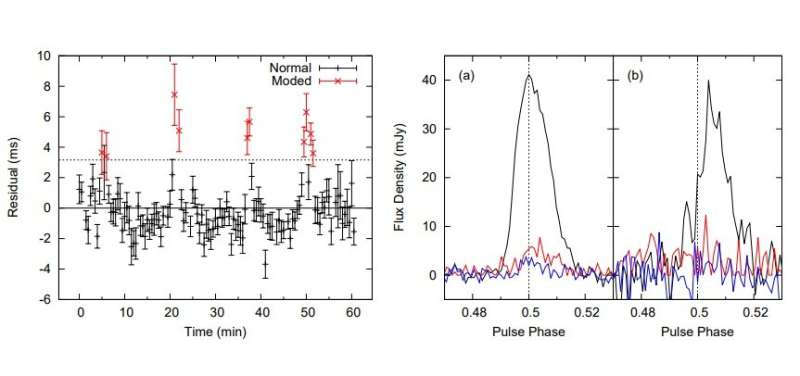May 26, 2020 report
Study unveils properties of 11 recently discovered pulsars

An international team of astronomers has conducted a detailed study of 11 pulsars recently discovered by the Five-hundred-meter Aperture Spherical radio Telescope (FAST). The new research, presented in a paper published May 19 on arXiv.org, delivers essential information about the properties of these objects.
Pulsars are highly magnetized, rotating neutron stars emitting a beam of electromagnetic radiation. They are usually detected in the form of short bursts of radio emission, however some of them are also observed using optical, X-ray and gamma-ray telescopes. To date, most pulsars have been discovered using the Parkes Observatory in Australia.
Recently, 11 new pulsars have been identified by China's FAST telescope and confirmed using the 64-meter Parkes Radio Telescope of Parkes Observatory. A group of astronomers, led by Andrew Cameron of the Commonwealth Scientific and Industrial Research Organisation (CSIRO), Australia, investigated these newfound pulsars in detail, hoping to get more insights into their properties. For this purpose, they conducted follow-up observations of this objects with the Parkes Radio Telescope and the 100-meter Effelsberg Radio Telescope located in Germany.
"In this paper, we describe 11 pulsars, discovered by FAST with the UWB [ultra-wide-bandwidth] receiver, that have now been monitored with the Parkes telescope for at least one year, thereby enabling a timing solution for each pulsar to be determined," the astronomers wrote in the paper.
In general, the study obtained timing models of each pulsar's spin properties and detailed evaluation of their emission properties, including flux calibration and polarization properties. The investigated pulsars were found to have spin periods ranging from 0.56 to 4.76 seconds, and characteristic ages between 0.65 and 320 million years.
According to the paper, one of the 11 pulsars, designated PSR J0344−0901, showcases a type of mode-changing behavior in its pulsations. The pulsar was found to transition between its "normal" and "moded" state, which takes place gradually over the course of many tens of seconds. It has a spin period of about 1.23 seconds, dispersion measure of 30.9 parsecs/cm3, and characteristic age of 5.58 million years.
Another interesting object in the sample is PSR J1926−0652, which exhibits many emission phenomena, including nulling and sub-pulse drifting. With a characteristic age of approximately 650,000 years, it is the youngest pulsar out of the 11 studied objects. It has a spin period of about 1.6 seconds and dispersion measure of 85.3 parsecs/cm3.
The most unremarkable of the pulsars presented in the paper is PSR J1931−0144. It exhibits a broad, single-component Gaussian pulse, a spin period of about 0.59 seconds, dispersion measure of 38.3 parsecs/cm3, and is the oldest pulsar in the studied sample.
Summing up the results, the astronomers say that their study paves the way for next-generation pulsar surveys on telescopes like FAST, MeerKAT and Square Kilometre Array (SKA).
More information: An in-depth investigation of 11 pulsars discovered by FAST, arXiv:2005.09171 [astro-ph.HE] arxiv.org/abs/2005.09171
© 2020 Science X Network





















